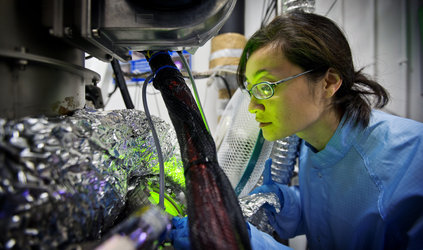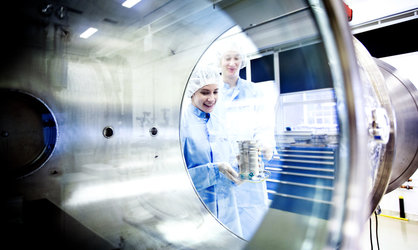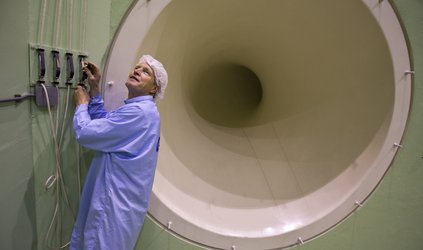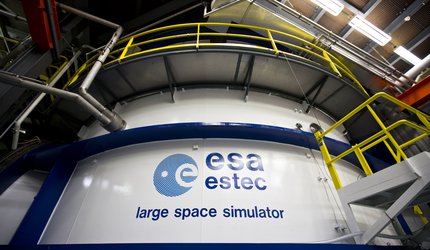Accept all cookies Accept only essential cookies See our Cookie Notice

About ESA
The European Space Agency (ESA) is Europe’s gateway to space. Its mission is to shape the development of Europe’s space capability and ensure that investment in space continues to deliver benefits to the citizens of Europe and the world.
Highlights
ESA - United space in Europe
This is ESA ESA facts Member States & Cooperating States Funding Director General Top management For Member State Delegations European vision European Space Policy ESA & EU Space Councils Responsibility & Sustainability Annual Report Calendar of meetings Corporate newsEstablishments & sites
ESA Headquarters ESA ESTEC ESA ESOC ESA ESRIN ESA EAC ESA ESAC Europe's Spaceport ESA ESEC ESA ECSAT Brussels Office Washington OfficeWorking with ESA
Business with ESA ESA Commercialisation Gateway Law at ESA Careers Cyber resilience at ESA IT at ESA Newsroom Partnerships Merchandising Licence Education Open Space Innovation Platform Integrity and Reporting Administrative Tribunal Health and SafetyMore about ESA
History ESA Historical Archives Exhibitions Publications Art & Culture ESA Merchandise Kids Diversity ESA Brand Centre ESA ChampionsLatest
Space in Member States
Find out more about space activities in our 23 Member States, and understand how ESA works together with their national agencies, institutions and organisations.
Science & Exploration
Exploring our Solar System and unlocking the secrets of the Universe
Go to topicAstronauts
Missions
Juice Euclid Webb Solar Orbiter BepiColombo Gaia ExoMars Cheops Exoplanet missions More missionsActivities
International Space Station Orion service module Gateway Concordia Caves & Pangaea BenefitsLatest
Space Safety
Protecting life and infrastructure on Earth and in orbit
Go to topicAsteroids
Asteroids and Planetary Defence Asteroid danger explained Flyeye telescope: asteroid detection Hera mission: asteroid deflection Near-Earth Object Coordination CentreSpace junk
About space debris Space debris by the numbers Space Environment Report In space refuelling, refurbishing and removingSafety from space
Clean Space ecodesign Zero Debris Technologies Space for Earth Supporting Sustainable DevelopmentApplications
Using space to benefit citizens and meet future challenges on Earth
Go to topicObserving the Earth
Observing the Earth Future EO Copernicus Meteorology Space for our climate Satellite missionsCommercialisation
ESA Commercialisation Gateway Open Space Innovation Platform Business Incubation ESA Space SolutionsLatest
Enabling & Support
Making space accessible and developing the technologies for the future
Go to topicBuilding missions
Space Engineering and Technology Test centre Laboratories Concurrent Design Facility Preparing for the future Shaping the Future Discovery and Preparation Advanced Concepts TeamSpace transportation
Space Transportation Ariane Vega Space Rider Future space transportation Boost! Europe's Spaceport Launches from Europe's Spaceport from 2012Latest

Large Space Simulator entrance
Thank you for liking
You have already liked this page, you can only like it once!
This is the engineer’s entrance to ESA’s Large Space Simulator, Europe’s largest vacuum chamber.
Entire satellites requiring testing in simulated space conditions are lowered down into the 15 m-high and 10 m-diameter chamber through a hatch on top.
Once the top and side hatches are sealed, the high-performance pumps can create a vacuum a billion times lower than standard sea level atmosphere, held for weeks at a time during test runs.
And it is more than just space vacuum that is simulated. The chamber’s black-hued interior walls are lined with tubes pumped full of –190°C liquid nitrogen to mimic the extreme cold of deep space.
Meanwhile, the hexagonal mirror array seen at the centre of the picture reflects simulated sunlight onto the satellite from a set of 25 kW bulbs more typically employed to project IMAX movies.
The alignment of the 121 mirror segments can be adjusted to tighten the focus of their reflected light beam, from the single ‘solar constant’ found in Earth orbit to upwards of 11 solar constants experienced in the vicinity of Mercury’s orbit. Later this year a prototype heatshield for ESA’s 2017 Solar Orbiter mission will be put through its paces in this manner.
Test satellites are attached to the turntable seen at the end of the walkway, to reproduce their orbital motion. The airlessness of space means a satellite can be both very hot and extremely cold at the same time, depending which part is in sunlight or shadow.
Embedded sensors and measurement devices check whether a mission’s thermal engineers have done their job well, and if the test satellite maintains an acceptable internal temperature range without buckling or other unwanted temperature-driven effects.
The Simulator is part of ESA’s Test Centre in the Netherlands, the largest facility of its kind in Europe, providing a complete suite of equipment for all aspects of satellite testing under a single roof.
-
CREDIT
ESA/Guus Schoonewille -
LICENCE
ESA Standard Licence

Large Space Simulator entrance

UV test facility at ESTEC

Preparing vacuum chamber in Propulsion Lab

Large European Acoustic Facility















 Germany
Germany
 Austria
Austria
 Belgium
Belgium
 Denmark
Denmark
 Spain
Spain
 Estonia
Estonia
 Finland
Finland
 France
France
 Greece
Greece
 Hungary
Hungary
 Ireland
Ireland
 Italy
Italy
 Luxembourg
Luxembourg
 Norway
Norway
 The Netherlands
The Netherlands
 Poland
Poland
 Portugal
Portugal
 Czechia
Czechia
 Romania
Romania
 United Kingdom
United Kingdom
 Slovenia
Slovenia
 Sweden
Sweden
 Switzerland
Switzerland

























